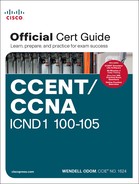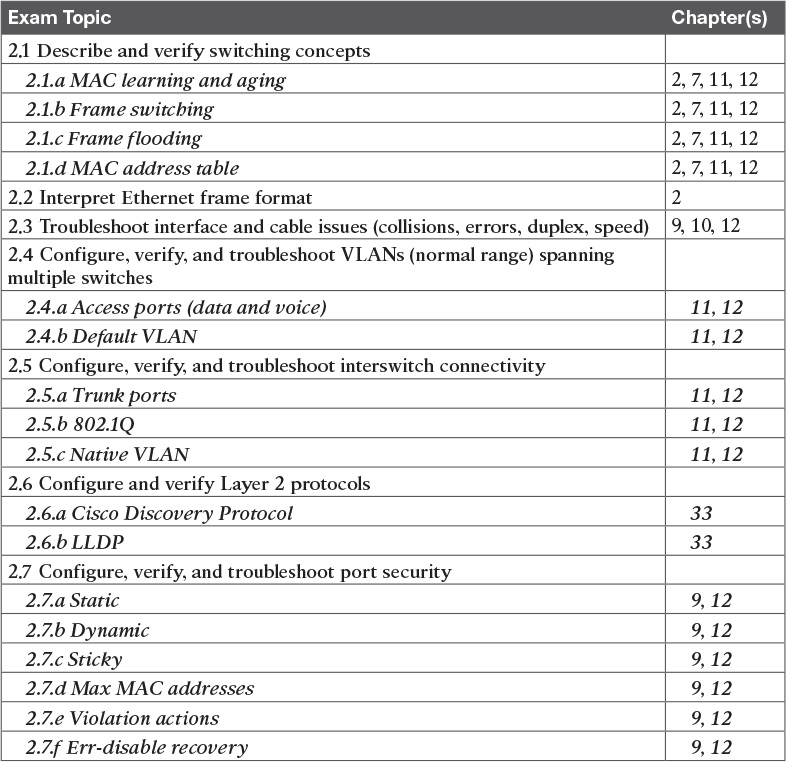Appendix R. Exam Topics Cross Reference
This appendix lists the exam topics associated with the ICND1 100-105 exam and the CCNA 200-125 exam. Cisco lists the exam topics on its website. Even though changes to the exam topics are rare, you should always review those exam topics for any updates; check www.cisco.com/go/certifications, and navigate to the correct exam.
Cisco organizes each list of exam topics by domains, which are major topic areas. Cisco states the percentage of the exam that should come from each exam, so you get some idea of the areas of importance. Traditionally, the score report you receive after taking the exam shows your percentage score in each domain.
This appendix includes three separate types of indices to exam topics:
![]() ICND1 100-105 Exam Topic Order: This section lists the ICND1 100-105 exam topics in the same order Cisco lists them on its website, with a list of associated book chapters. This first list shows a cross reference from each exam topic to the chapters that include at least some material about each topic.
ICND1 100-105 Exam Topic Order: This section lists the ICND1 100-105 exam topics in the same order Cisco lists them on its website, with a list of associated book chapters. This first list shows a cross reference from each exam topic to the chapters that include at least some material about each topic.
![]() Book Chapter Order Versus ICND1 100-105 Exam Topics: This lists the same ICND1 100-105 exam topics but indexed by chapter instead of exam topic. This section lists the chapters in this book, along with the exam topics that the chapter includes. This section basically re-lists the kind of information found on the first page of each chapter, just in condensed form in one place.
Book Chapter Order Versus ICND1 100-105 Exam Topics: This lists the same ICND1 100-105 exam topics but indexed by chapter instead of exam topic. This section lists the chapters in this book, along with the exam topics that the chapter includes. This section basically re-lists the kind of information found on the first page of each chapter, just in condensed form in one place.
![]() CCNA 200-125 Exam Topic Order: This final section of the chapter lists the CCNA 200-125 exam topics. This third list highlights the CCNA 200-125 exam topics that overlap with the ICND1 100-105 exam topics.
CCNA 200-125 Exam Topic Order: This final section of the chapter lists the CCNA 200-125 exam topics. This third list highlights the CCNA 200-125 exam topics that overlap with the ICND1 100-105 exam topics.
ICND1 100-105 Exam Topic Order
The ICND1 100-105 Exam includes five major topic areas (domains), each with a percentage listed. Table R-1 lists the domains and their percentages.
Tables R-2 through R-6 list the exam topics within each of the five domains.
Book Chapters, with Exam Topics Covered in Each
Cisco organizes its exam topics based on the outcome of your learning experience, which is typically not a reasonable order for building the content of a book or course. This section lists the book chapters in sequence, with the exam topics covered in each chapter.





CCNA R&S 200-125 Exam Topics
The CCNA R&S 200-125 exam includes the exam topics from the ICND1 100-105 plus the ICND2 200-105 exams. The following list details Cisco’s posted exam topics for the CCNA Routing and Switching 200-125 exam. It also highlights the items that exactly match the ICND1 100-105 exam topics.
The CCNA R&S 200-125 exam includes seven major topic areas (domains), each with a percentage listed. Table R-7 lists the domains and their percentages.
1.0 Network Fundamentals
1.1 Compare and contrast OSI and TCP/IP models
1.2 Compare and contrast TCP and UDP protocols
1.3 Describe the impact of infrastructure components in an enterprise network
1.3.a Firewalls
1.3.b Access points
1.3.c Wireless controllers
1.4 Describe the effects of cloud resources on enterprise network architecture
1.4.a Traffic path to internal and external cloud services
1.4.b Virtual services
1.4.c Basic virtual network infrastructure
1.5 Compare and contrast collapsed core and three-tier architectures
1.6 Compare and contrast network topologies
1.6.a Star
1.6.b Mesh
1.6.c Hybrid
1.7 Select the appropriate cabling type based on implementation requirements
1.8 Apply troubleshooting methodologies to resolve problems
1.8.a Perform fault isolation and document
1.8.b Resolve or escalate
1.8.c Verify and monitor resolution
1.9 Configure, verify, and troubleshoot IPv4 addressing and subnetting
1.10 Compare and contrast IPv4 address types
1.10.a Unicast
1.10.b Broadcast
1.10.c Multicast
1.11 Describe the need for private IPv4 addressing
1.12 Identify the appropriate IPv6 addressing scheme to satisfy addressing requirements in a LAN/WAN environment
1.13 Configure, verify, and troubleshoot IPv6 addressing
1.14 Configure and verify IPv6 Stateless Address Auto Configuration
1.15 Compare and contrast IPv6 address types
1.15.a Global unicast
1.15.b Unique local
1.15.c Link local
1.15.d Multicast
1.15.e Modified EUI 64
1.15.f Autoconfiguration
1.15.g Anycast
2.0 LAN Switching Technologies
2.1 Describe and verify switching concepts
2.1.a MAC learning and aging
2.1.b Frame switching
2.1.c Frame flooding
2.1.d MAC address table
2.2 Interpret Ethernet frame format
2.3 Troubleshoot interface and cable issues (collisions, errors, duplex, speed)
2.4 Configure, verify, and troubleshoot VLANs (normal/extended range) spanning multiple switches
2.4.a Access ports (data and voice)
2.4.b Default VLAN
2.5 Configure, verify, and troubleshoot interswitch connectivity
2.5.a Trunk ports
2.5.b Add and remove VLANs on a trunk
2.5.c DTP, VTP (v1&v2), and 802.1Q
2.5.d Native VLAN
2.6 Configure, verify, and troubleshoot STP protocols
2.6.a STP mode (PVST+ and RPVST+)
2.6.b STP root bridge selection
2.7 Configure, verify and troubleshoot STP related optional features
2.7.a PortFast
2.7.b BPDU guard
2.8 Configure and verify Layer 2 protocols
2.8.a Cisco Discovery Protocol
2.8.b LLDP
2.9 Configure, verify, and troubleshoot (Layer 2/Layer 3) EtherChannel
2.9.a Static
2.9.b PAGP
2.9.c LACP
2.10 Describe the benefits of switch stacking and chassis aggregation
3.0 Routing Technologies
3.1 Describe the routing concepts
3.1.a Packet handling along the path through a network
3.1.b Forwarding decision based on route lookup
3.1.c Frame rewrite
3.2 Interpret the components of routing table
3.2.a Prefix
3.2.b Network mask
3.2.c Next hop
3.2.d Routing protocol code
3.2.e Administrative distance
3.2.f Metric
3.2.g Gateway of last resort
3.3 Describe how a routing table is populated by different routing information sources
3.3.a Admin distance
3.4 Configure, verify, and troubleshoot inter-VLAN routing
3.4.a Router on a stick
3.4.b SVI
3.5 Compare and contrast static routing and dynamic routing
3.6 Compare and contrast distance vector and link state routing protocols
3.7 Compare and contrast interior and exterior routing protocols
3.8 Configure, verify, and troubleshoot IPv4 and IPv6 static routing
3.8.a Default route
3.8.b Network route
3.8.c Host route
3.8.d Floating static
3.9 Configure, verify, and troubleshoot single area and multiarea OSPFv2 for IPv4 (excluding authentication, filtering, manual summarization, redistribution, stub, virtual-link, and LSAs)
3.10 Configure, verify, and troubleshoot single area and multiarea OSPFv3 for IPv6 (excluding authentication, filtering, manual summarization, redistribution, stub, virtual-link, and LSAs)
3.11 Configure, verify, and troubleshoot EIGRP for IPv4 (excluding authentication, filtering, manual summarization, redistribution, stub)
3.12 Configure, verify, and troubleshoot EIGRP for IPv6 (excluding authentication, filtering, manual summarization, redistribution, stub)
3.13 Configure, verify, and troubleshoot RIPv2 for IPv4 (excluding authentication, filtering, manual summarization, redistribution)
3.14 Troubleshoot basic Layer 3 end-to-end connectivity issues
4.0 WAN Technologies
4.1 Configure and verify PPP and MLPPP on WAN interfaces using local authentication
4.2 Configure, verify, and troubleshoot PPPoE client-side interfaces using local authentication
4.3 Configure, verify, and troubleshoot GRE tunnel connectivity
4.4 Describe WAN topology options
4.4.a Point-to-point
4.4.b Hub and spoke
4.4.c Full mesh
4.4.d Single vs dual-homed
4.5 Describe WAN access connectivity options
4.5.a MPLS
4.5.b Metro Ethernet
4.5.c Broadband PPPoE
4.5.d Internet VPN (DMVPN, site-to-site VPN, client VPN)
4.6 Configure and verify single-homed branch connectivity using eBGP IPv4 (limited to peering and route advertisement using Network command only)
4.7 Describe basic QoS concepts
4.7.a Marking
4.7.b Device trust
4.7.c Prioritization
4.7.c.1 Voice
4.7.c.2 Video
4.7.c.3 Data
4.7.d Shaping
4.7.e Policing
4.7.f Congestion management
5.0 Infrastructure Services
5.1 Describe DNS lookup operation
5.2 Troubleshoot client connectivity issues involving DNS
5.3 Configure and verify DHCP on a router (excluding static reservations)
5.3.a Server
5.3.b Relay
5.3.c Client
5.3.d TFTP, DNS, and gateway options
5.4 Troubleshoot client- and router-based DHCP connectivity issues
5.5 Configure, verify, and troubleshoot basic HSRP
5.5.a Priority
5.5.b Preemption
5.5.c Version
5.6 Configure, verify, and troubleshoot inside source NAT
5.6.a Static
5.6.b Pool
5.6.c PAT
5.7 Configure and verify NTP operating in a client/server mode
6.0 Infrastructure Security
6.1 Configure, verify, and troubleshoot port security
6.1.a Static
6.1.b Dynamic
6.1.c Sticky
6.1.d Max MAC addresses
6.1.e Violation actions
6.1.f Err-disable recovery
6.2 Describe common access layer threat mitigation techniques
6.2.a 802.1x
6.2.b DHCP snooping
6.2.c Nondefault native VLAN
6.3 Configure, verify, and troubleshoot IPv4 and IPv6 access list for traffic filtering
6.3.a Standard
6.3.b Extended
6.3.c Named
6.4 Verify ACLs using the APIC-EM ACL Analysis tool
6.5 Configure, verify, and troubleshoot basic device hardening
6.5.a Local authentication
6.5.b Secure password
6.5.c Access to device
6.5.c.1 Source address
6.5.c.2 Telnet/SSH
6.5.d Login banner
6.6 Describe device security using AAA with TACACS+ and RADIUS
7.0 Infrastructure Management
7.1 Configure and verify device-monitoring protocols
7.1.a SNMPv2
7.1.b SNMPv3
7.1.c Syslog
7.2 Troubleshoot network connectivity issues using ICMP echo-based IP SLA
7.3 Configure and verify device management
7.3.a Backup and restore device configuration
7.3.b Using Cisco Discovery Protocol or LLDP for device discovery
7.3.c Licensing
7.3.d Logging
7.3.e Timezone
7.3.f Loopback
7.4 Configure and verify initial device configuration
7.5 Perform device maintenance
7.5.a Cisco IOS upgrades and recovery (SCP, FTP, TFTP, and MD5 verify)
7.5.b Password recovery and configuration register
7.5.c File system management
7.6 Use Cisco IOS tools to troubleshoot and resolve problems
7.6.a Ping and traceroute with extended option
7.6.b Terminal monitor
7.7.c Log events
7.7.d Local SPAN
7.7 Describe network programmability in enterprise network architecture
7.7.a Function of a controller
7.7.b Separation of control plane and data plane
7.7.c Northbound and southbound APIs

















